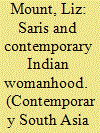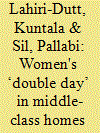| Srl | Item |
| 1 |
ID:
155746


|
|
|
|
|
| Summary/Abstract |
Despite the major changes in urban middle-class Indian women’s clothing in the past 30 years, there are few accounts of women’s perspectives on their changing dress. This paper analyzes 31 semi-structured interviews with urban middle-class women in Delhi, Mumbai, and Pune to examine the changing meanings associated with saris in contemporary India. While the sari has entered the realm of global fashion and can thus be characterized as modern and sexy, the garment remains strongly associated with respect and maturity for women, particularly within their families, but also in public spaces and in the workplace. Women link their practices of sari wearing to modern aspirations by emphasizing saris as ‘modern’ fashionable attire, while simultaneously reinforcing the sari as a symbol of traditional, respectable married womanhood, thus exploiting the traditional meanings that the sari confers on them to their advantage. The emphasis on saris as simultaneously ‘modern’ and representative of Indian tradition indicates the cultural pressure placed on middle-class women to conform to dictates of traditional womanhood while also aligning themselves with modernity.
|
|
|
|
|
|
|
|
|
|
|
|
|
|
|
|
| 2 |
ID:
136300


|
|
|
|
|
| Summary/Abstract |
As middle-class Indian women become economically more active, it is worth exploring who is doing the housework. Are gender roles shifting within the household across the board in urban India? This paper shifts research attention away from the metropolitan cities to a small mofussil town, a relatively conservative urban centre where gender roles have so far been more resistant to transformation than in metropolitan cities that are undergoing radical changes about which much has been written. The methodological tool used in the study is a time-use survey, aimed primarily at extracting quantitative data, to make visible the unseen, unpaid and underpaid work and activities undertaken by women. Individual interviews were used to measure the actual workload of the women as a proxy indicator of gender disparities at the intra-household scale. The paper concludes that conventional sex segregation in household tasks has not changed significantly, and that women's various engagements in the public sphere have doubled the burden of responsibilities. The conceptual and methodological implications of the investigation lie in a reinterpretation of what constitutes ‘work’ for middle-class women, offering renewed understanding of the ways in which women (re)negotiate gendered responsibilities at home and outside of it in rapidly changing times.
|
|
|
|
|
|
|
|
|
|
|
|
|
|
|
|